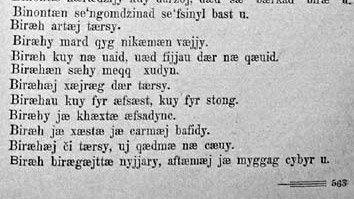Æ

Æ (minuscule: æ) is a grapheme named æsc or ash, formed from the letters a and e, originally a ligature representing a Latin diphthong. It has been promoted to the full status of a letter in the alphabets of some languages, including Norwegian, Danish, Icelandic, and Faroese. As a letter of the Old English Latin alphabet, it was called æsc ("ash tree") after the Anglo-Saxon futhorc rune ᚫ (![]() ) which it transliterated; its traditional name in English is still ash /æʃ/. It was also used in Old Swedish before being changed to ä. Variants include Ǣ ǣ Ǽ ǽ.
) which it transliterated; its traditional name in English is still ash /æʃ/. It was also used in Old Swedish before being changed to ä. Variants include Ǣ ǣ Ǽ ǽ.


Latin
In Classical Latin, the combination AE denotes the diphthong [ai̯], which had a value similar to the long i in fine as pronounced in most dialects of Modern English.[1] Both classical and present practice is to write the letters separately, but the ligature was used in medieval and early modern writings, in part because æ was reduced to the simple vowel [ɛ] during the Roman Empire. In some medieval scripts, the ligature was simplified to ę, an e with ogonek, the e caudata. That was further simplified into a plain e, which may have influenced or been influenced by the pronunciation change. However, the ligature is still relatively common in liturgical books and musical scores.
Greek
The digraph ae was used in Latin to transliterate the Greek diphthong αι (alpha iota). Modern scientific vocabulary that borrows from Greek continues to use Latin transliteration conventions.
French
In the modern French alphabet, æ is used to spell Latin and Greek borrowings like tænia and ex æquo. It was greatly popularized in Serge Gainsbourg's song Elaeudanla Téïtéïa (i.e. "L, A, E dans l'A, T, I, T, I, A"), which is the spelling in French of the name Lætitia.
Germanic languages
English
In English, usage of the ligature varies in different places. In modern typography, and where technological limitations make its use difficult (such as in use of typewriters, first telegraphs, or ASCII), æ is often eschewed in favour of the digraph ae. Usage experts often consider that incorrect, especially for foreign words in which æ is considered a letter (such as Æsir, Ærø) or brand names that use the ligature or a variation of it (e.g., Æon Flux, Encyclopædia Britannica, Aetna, Inc.). In the United States, the problem of the ligature is sidestepped in many cases by use of a simplified spelling with "e", as happened with œ as well. Usage, however, may vary; for example, medieval is now more common than mediaeval (and the now old-fashioned mediæval) even in the United Kingdom,[2] but archaeology is preferred over archeology even in the US.[3]
Given their long history, ligatures are sometimes used to invoke archaism or in literal quotations of historic sources; for instance, words such as dæmon or æther are often treated so.
The ligature is seen on gravestones of the 19th century, short for "ætate" ("at the age of"): "Æ xxYs, yyMs, zzDs." It is also common in formal typography (invitations, resolutions, announcements, and some government documents).
Old English
In Old English, æ represented a sound between a and e (/æ/), a sound very much like the short a of cat in many dialects of Modern English. If long vowels are distinguished from short vowels, the long version /æː/ is marked with a macron (ǣ) or less commonly an acute (ǽ).
Old Norse
In Old Norse, æ represents the long vowel /ɛː/. The short version of the same vowel, /ɛ/, if it is distinguished from /e/, is written as ę.
Faroese
In most varieties of Faroese, æ is pronounced as follows:
- [ɛa] when simultaneously stressed and occurring either word-finally, before a vowel letter, before a single consonant letter, or before the consonant-letter groups kl, kr, pl, pr, tr, kj, tj, sj and those consisting of ð and one other consonant letter except for ðr when pronounced like gr (except as below)
- a rather open [eː] when directly followed by the sound Faroese pronunciation: [a], as in ræðast (silent ð) and frægari (silent g)
- Faroese pronunciation: [a] in all other cases
One of its etymological origins is Old Norse é (the other is Old Norse æ), which is particularly evident in the dialects of Suðuroy, where Æ is Faroese pronunciation: [eː] or [ɛ]:
- æða (eider): Suð. [eːa], Northern Faroese [ɛaːva]
- ætt (family, direction): Suð. [ɛtː], Northern Faroese [atː]
Icelandic
In Icelandic, æ signifies the diphthong [ai].
Danish and Norwegian
In Danish and Norwegian, æ is a separate letter of the alphabet that represents a monophthong. In Norwegian, there are four ways of pronouncing the letter:
- /æː/ as in æ (the name of the letter), bær, læring, æra, Ænes, ærlig, tærne, Kværner, Dæhlie, særs, ærfugl, lært, trær ("trees")
- /æ/ as in færre, æsj, nærmere, Færder, Skjærvø, ærverdig, vært, lærd, Bræin (where æi is pronounced as a diphthong /æi/)
- /eː/ as in Sæther, Næser, Sæbø, gælisk, spælsau, bevæpne, sæd, æser, Cæsar, væte, trær ("thread(s)" (verb))
- /e/ as in Sæth, Næss, Brænne, Bækkelund, Vollebæk, væske, trædd

In many western, northern, and southwestern Norwegian dialects and in the western Danish dialects of Thy and Southern Jutland, æ has a significant meaning: the first person singular pronoun I. It is thus a normal spoken word; usually, it is written as æ when such dialects are rendered in writing.
In western and southern Jutish dialects of Danish, æ is also the proclitic definite article: æ hus (the house), as opposed to Standard Danish and all other Nordic varieties which have enclitic definite articles (Danish, Swedish, Norwegian: huset, Icelandic, Faroese: húsið (the house)). The dialects are rarely committed to writing except for some dialect literature.
German
In the normalized spelling of Middle High German æ is used to represent a long vowel [ɛː]. The actual spelling in mediaeval text varies, however.
Ossetic

Ossetic used the letter æ when it was written using the Latin script from 1923 to 1938. Since then, Ossetian has used a Cyrillic alphabet with an identical-looking letter (Ӕ and ӕ). It is pronounced as a mid-central vowel (schwa).
South American languages
The letter æ is used in the official orthography of Kawésqar spoken in Chile and also in that of the Fuegian language Yaghan.
International Phonetic Alphabet
The symbol [æ] is also used in the International Phonetic Alphabet to denote a near-open front unrounded vowel like in the word cat in many dialects of Modern English, which is the sound that was most likely represented by the Old English letter. In the IPA, it is l always in lowercase.
Computer encodings and entering

On Norwegian keyboards the Æ and Ø trade places.

| Preview | Æ | æ | ||
|---|---|---|---|---|
| Unicode name | LATIN CAPITAL LETTER AE | LATIN SMALL LETTER AE | ||
| Encodings | decimal | hex | dec | hex |
| Unicode | 198 | U+00C6 | 230 | U+00E6 |
| UTF-8 | 195 134 | C3 86 | 195 166 | C3 A6 |
| Numeric character reference | Æ |
Æ |
æ |
æ |
| Named character reference | Æ | æ | ||
- When using the Latin-1 or Unicode/HTML character sets, the code points for Æ and æ are U+00C6 Æ LATIN CAPITAL LETTER AE (Æ) and U+00E6 æ LATIN SMALL LETTER AE (æ), respectively.
- The characters can be entered by holding the Alt key while typing in 0198 (upper case) or 0230 (lower case) on the number pad on Windows systems (the Alt key and 145 for æ or 146 for Æ may also work from the legacy IBM437 codepage).
- In the TeX typesetting system, ӕ is produced by \ae.
- In Microsoft Word, Æ and æ can be written using the key combination CTRL + SHIFT + & followed by A or a respectively.
- On US-International keyboards, Æ is accessible with the combination of AltGr+z.
- In X, AltGr+A is often mapped to æ/Æ, or a Compose key sequence Compose + a + e can be used. For more information, see Unicode input.
- In all versions of the Mac OS (Systems 1 through 7, Mac OS 8 and 9, and the current OS X), the following key combinations are used: æ: Option + ' (apostrophe key), Æ: Option + Shift + '.
- On the iPhone, iPod touch and iPad, as well as phones running Google's Android OS or Windows Mobile OS and on the Kindle Touch and Paperwhite, æ and Æ are accessed by holding down "A" until a small menu is displayed.
- The Icelandic keyboard layout has a separate key for Æ (and Ð, Þ and Ö).
- Cyrillic
- There is also the Cyrillic Ӕ and ӕ in Unicode (U+04D4 Ӕ CYRILLIC CAPITAL LIGATURE A IE and U+04D5 ӕ CYRILLIC SMALL LIGATURE A IE; note the name being A IE), though in practice the Latin letters Æ and æ (U+00C6, U+00E6) are used in Cyrillic texts (such as on Ossetian sites on the Internet).
See also
- Æ (Cyrillic)
- Ae (digraph)
- Å
- Ä
- E caudata
- Ø
- Ö
- Œ
- Near-open front unrounded vowel (represented by æ in the IPA)
- Ə
- Ansuz rune
- List of words that may be spelled with a ligature
- Anavae
References
- ^ James Morwood (1999). Latin Grammar, Oxford University Press. ISBN 978-0-19-860199-9, p. 3
- ^ The spelling medieval is given priority in both Oxford and Cambridge Advanced Learner's Dictionary. Accessed September 22, 2014.
- ^ Merriam-Webster Advanced Learner's Dictionary. Accessed September 22, 2014.
- Robert Bringhurst (2002). The Elements of Typographic Style, page 271. Vancouver, Hartley & Marks. ISBN 0-88179-205-5
